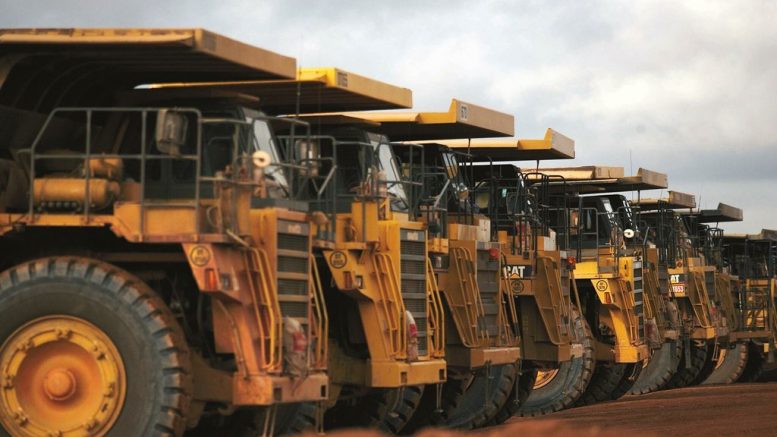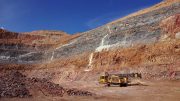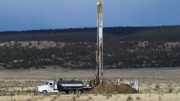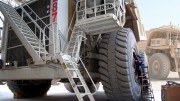Mining in the United States has been ongoing for centuries and has played a role in the country’s development over the years. The Northern Miner presents its annual Top-10 listing of the largest U.S.-based mining companies, which are ranked by market capitalization, as of July 24, 2020.
1. Newmont
Market cap: US$53.6 billion

The Kalgoorlie Super Pit gold mine, adjacent to the city of Kalgoorlie–Boulder, 600 km east of Perth, Western Australia. Newmont recently sold its 50% stake in the mine to Northern Star Resources for US$800 million ($1 billion). Credit: Newmont.
Newmont (TSX: NGT, NYSE: NEM) is one of the world’s largest gold producers, with operations in the Americas, Africa and Australia.
Over the next decade, the company’s guidance is for 6 million oz. to 7 million oz. annual gold output, with an additional contribution expected from 1.2 million to 1.4 million oz. gold-equivalent each year.
The company’s business model is built around the concept of ‘world-class’ assets, which it defines as gold operations producing at least 500,000 oz. gold-equivalent annually on a consolidated basis at all-in sustaining costs (AISCs) of under US$900 per ounce. In addition, in order for a mine to meet this threshold, it needs to have a life greater than 10 years and be within a ‘top-tier’ jurisdiction, based on credit agency ratings.
Newmont’s operations include the Boddington mine in Australia, expected to produce over 1 million oz. gold-equivalent annually in the near-term, and the Penasquito open-pit in Mexico, forecast to churn out over 1.5 million oz. gold-equivalent over the next four years. The Nevada Gold Mines joint venture, where Newmont has a 38.5% stake, also features 18.6 million oz. gold in reserves, with an operating life in excess of 10 years.
Founded in the U.S. in 1921, the company established a Canadian presence in 2019, with its US$10 billion acquisition of Goldcorp, which closed in April of that year.
Alongside this merger, also in 2019, Newmont and Barrick (TSX: ABX, NYSE: GOLD) formed a joint venture in Nevada, called Nevada Gold Mines, with the latter holding a 61.5% interest in the partnership.
2. Southern Copper
Market cap: US$33.3 billion

Processing equipment at Southern Copper’s Toquepala copper mine in southern Peru. Credit: Southern Copper.
Southern Copper (NYSE: SCCO) is one of the world’s top producers of copper and, according to the company, has the largest reserves in the industry. Southern Copper is 88.9% owned by publicly traded Grupo Mexico, a Mexican mining company and one of the world’s largest copper producers.
The company produces copper, molybdenum, zinc and silver with mining, smelting and refining facilities in Peru and Mexico.
Peruvian assets include the Toquepala and Cuajone mine complexes with smelting and refining plants, as well as an industrial railroad and port that service both mines. The operations produce copper as well as byproducts such as molybdenum and silver.
In Mexico, Southern Copper holds the La Caridad and Buenavista open pit sites, producing silver, copper and molybdenum. An additional five underground operations in the country generate zinc, copper, lead and precious metals. The company also holds a coal mine and a zinc refinery in Mexico.
The company’s copper concentrates are smelted to produce either blister copper (as cakes with air pockets) or copper anodes (without the air pockets). Both products are sent to a refinery, where anodes are converted into copper cathodes and, later, copper rods.
Last year, Southern Copper refined a total of 783,349 tonnes copper, 12.6 million oz. silver and 104,977 tonnes zinc.
The company’s exploration efforts are focused on Argentina, Chile, Ecuador, Mexico and Peru.
3. Freeport McMoRan
Market cap: US$19.1 billion

Copper cathode at the Tenke Fungurume project in 2015. Credit: Freeport-McMoRan.
Phoenix-headquartered Freeport McMoRan (NYSE: FCX) is one of the world’s largest publicly traded copper producers and operates a portfolio of metal mines in the Americas and Indonesia.
Over 70% of the company’s copper reserves and sales are from the United States, where it holds seven open-pit copper assets as well as two molybdenum mines. The operations also generate gold and silver.
Freeport is also working to develop the Lone Star leach project, nearby its Safford mine in Arizona, with first production expected this year. The asset would contribute approximately 90,718 tonnes copper annually, once ramped up.
In South America, FCX operates two copper mines in Peru and Chile – Cerro Verde and El Abra. An expansion study is also underway for El Abra, where a large sulphide inventory could support a mill expansion.
The company’s Indonesian subsidiary has a 48.8% stake in the Grasberg operation (51.2% is held by an Indonesian state-owned enterprise). Last year, mining of the open pit was completed and a transition to underground-only operations is underway. This asset is expected to generate an average of 635,029 tonnes copper per year between 2020 and 2024, as the underground scales up.
In 2019, Freeport produced approximately 1.5 million tonnes of copper and 882,000 oz. gold on a consolidated basis – 45% of the copper output was from the U.S., a further 36% was sourced out of South America, with the remaining 19% coming from Indonesia. The company also sold 40,823 tonnes molybdenum last year.
4. Albemarle
Market cap: US$9.3 billion

An aerial view of Tianqi Lithium and Albemarle’s Greenbushes lithium mine in southwestern Australia. Credit: Tianqi Lithium.
Albemarle (NYSE: ALB) is a global chemicals company with lithium, bromine and catalyst business segments.
As part of its lithium business, the company produces lithium compounds for a variety of applications and industries and offers recycling services for lithium-containing byproducts. Albemarle’s lithium is generated through solar evaporation at ponds in Chile’s Salar de Atacama and in Silver Peak, Nevada. The Chilean lithium brines are processed into lithium carbonate and lithium chloride at an in-country plant, whereas the Nevada brines are processed into lithium carbonate in Silver Peak.
Albemarle’s mineral rights in Chile cover 167 sq. km, which, according to the company, should allow it to produce over 80,000 tonnes of technical and battery-grade lithium salts annually for 24 years.
At 54.6 sq. km, its Nevada site encompasses the lithium-bearing Clayton Valley basin. The company also generates mined lithium through its 49% interest in Australia-based Talison Lithium (51% is held by Tianqi Lithium, a Chinese publicly traded manufacturing company).
Its Bromine segment generates products for fire safety and other specialty applications. Albemarle’s catalysts division produces catalysts, additives and performance catalyst solutions.
Last year, the company recorded sales of US$1.4-billion from its lithium division, a 36.4% increase over 2018, revenues of US$1 billion from the bromine unit, and a further US$1.1 billion in sales from the catalysts business for a total adjusted EBITDA of US$1 billion.
Albemarle estimates that 50% of its revenues are from Asia (including 13% from China), 26% of its sales are generated by North American operations, and 23% of revenues are from Europe, the Middle East and Africa.
5. Royal Gold
Market cap: US$8.9 billion
Royal Gold (NASDAQ: RGLD) is a streaming and royalty company focused on precious metals. The company’s portfolio includes over 42 producing assets. In addition, Royal Gold holds interests in 16 development-stage projects and 129 exploration and evaluation-stage properties.
Last year, 78% of Royal Gold’s revenue was derived from gold, and the company sourced 37% and 20% of its sales out of Canada and the Dominican Republic, respectively.
The company’s key royalty and streaming interests include a metal stream on Teck Resources’ (TSX: TECK.A, TECK.B; NYSE: TECK) Andacollo copper-gold open pit in Chile, royalties on deposits at Nevada Gold Mines’ Cortez mine, as well as a metal stream on Centerra Gold’s (TSX: CG) Mount Milligan copper-gold mine. It also holds metal streams on the Pueblo Viejo open pit in the Dominican Republic, held by Barrick and Newmont, and on New Gold’s (TSX, NYSE: NGD) Rainy River mine in Ontario.
Last year, Royal Gold recorded revenues of US$423 million and generated US$253 million from operating activities.
According to the company, approximately 60% of its revenues are from operations in the first and second quartiles of the gold cash cost curve.
Royal Gold is focused on achieving strong returns for its shareholders. It funds its growth through cash flow and debt and, as of the end of March, had approximately US$1 billion in available liquidity.
6. Mosaic
Market cap: US$5.2 billion
Mosaic (NYSE: MOS) is one of the world’s largest producers of concentrated phosphate and potash crop nutrients.
The company is organized into three business segments: phosphates, which operates mines and production facilities in Florida; potash, operating potash mines and facilities in Canada and the U.S.; and its Brazil-based Mosaic Fertilizantes unit, acquired in 2018.
Mosaic’s phosphate mines include sites in central Florida and a joint venture in Peru, and its potash projects include three mines in Saskatchewan and one underground operation in New Mexico.
In January 2018, Mosaic completed its acquisition of Vale Fertilizantes, which added five phosphate mines, four phosphate chemical plants and a potash mine in Brazil to the company’s portfolio.
Due to last year’s market weakness, the company has taken steps to temporarily reduce its fertilizer production. In the second half of 2019, Mosaic decreased its phosphate output from facilities in central Florida and Louisiana and announced that it would reduce production at its Esterhazy potash mine in Saskatchewan.
This year’s total global potash shipment guidance stands at 63.5 million tonnes to 66.4 million tonnes, with 63.7 million tonnes shipped last year, with a further 69.2 million tonnes to 71.8 million tonnes of phosphate shipments expected this year (versus 70.7 million tonnes of phosphate shipped last year).
In April, the company combined its North American potash and phosphate operations under one management team, which is expected to leverage synergies between the two units.
7. Hecla Mining
Market cap: US$2.7 billion

Miners at Hecla Mining’s Lucky Friday underground silver operation in Idaho. Credit: Hecla Mining.
Hecla Mining (NYSE: HL) is a silver and gold producer with assets in the U.S., Canada and Mexico. The company, founded in 1891, is the largest primary producer of silver in the U.S. and the fifth largest gold producer in Quebec.
This year, Hecla expects to generate 10.9 million-11.9 million oz. silver and 195,000-208,000 oz. gold.
Hecla’s wholly owned Greens Creek underground mine in southeast Alaska is, according to the company, one of the largest and lowest-cost primary silver mines in the world. Last year, Greens Creek churned out 9.9 million oz. silver and 56,625 oz. gold at cash costs of US$1.97 per oz. silver, after by-product credits.
In western Quebec, Hecla’s wholly owned Casa Berardi underground gold mine produced 134,409 oz. gold last year at cash costs (after by-product credits) of US$1,051 per oz. and was acquired back in 2013 through its acquisition of Aurizon Mines.
In 2018, the company acquired Klondex Mines in a US$462-million cash-and-share deal, which added the Fire Creek, Hollister and Midas gold and silver mines in Nevada to its asset portfolio.
In Idaho, Hecla holds the Lucky Friday underground operation, within the state’s Coeur d’Alene mining district. The mine has been producing silver since 1942 and, according to the company, still has 20 to 30 years of mine life ahead.
Hecla’s Mexican asset is the San Sebastian silver and gold mine, which started up in 2015 and covers 420 sq. km within the Mexican Silver Belt.
The company’s pre-production assets include the Montanore silver-copper deposit in Montana as well as the Rock Creek property, 80 km north of the Lucky Friday mine. Hecla also holds exploration properties in Colorado, Idaho and Nevada as well as B.C. and Quebec.
8. Alcoa
Market cap: US$2.4 billion

The tower at Alcoa’s North plant in Tennessee. Photo by Brian Stansberry.
Alcoa (NYSE: AA) generates bauxite, alumina and aluminum. The company is one of the world’s top producers of bauxite and the largest alumina producer outside of China. Its aluminum unit includes smelting, casting, rolling and energy assets.
Although aluminum is an abundant element, it requires multiple steps before it can be transformed into aluminum: alumina oxide from bauxite rock needs to be refined into alumina, which is then smelted into aluminum.
The company’s bauxite and alumina segments include Alcoa World Alumina and Chemicals (AWAC), a joint venture between Alcoa and Alumina Limited (ASX: AWC), in which Alcoa holds a 60% stake. AWAC mines bauxite and other aluminum-bearing material and refines, produces and sells alumina-based chemicals.
Alcoa’s bauxite unit holds a total of seven mines. The company is one of the world’s top producers of the material, and its Huntly operation in Australia is the second-largest bauxite mine worldwide. On the alumina front, the U.S.-based company operates six refineries in Australia, Brazil and Spain, and has a 25% share in a refinery within the Ma’aden joint venture in Saudi Arabia. In Australia, Alcoa’s three-refinery operation is the world’s top source of alumina.
Last year, Alcoa produced 47.4 million tonnes of bauxite, 13.3 million tonnes of alumina and 2.1 million tonnes of aluminum. This year, it expects to ship 48-49 million tonnes of bauxite, 13.6-13.7 million tonnes of alumina and 3-3.1 million tonnes of aluminum.
9. Cleveland-Cliffs
Market cap: US$2.3 billion
With a history dating back to 1850 in the U.S. Midwest, Cleveland-based Cleveland-Cliffs (NYSE: CLF) is the oldest and largest independent iron miner in the country. The company’s mines and pellet plants supply the North American steel industry with iron ore pellets.
In March, Cleveland-Cliffs closed a US$3-billion acquisition of AK Steel, a publicly traded producer of carbon, stainless and electrical steel. The deal is intended to vertically integrate Cliffs’ high-value added steel offerings and expand its customer base into the automotive industry.
In the fourth quarter of 2020, construction is expected to be completed at the hot-briquetted iron (HBI) plant in Ohio, which is expected to position Cliffs as the only producer of high-quality HBI steel for the electric arc furnace steel market within the Great Lakes region. The Toledo-based plant will have the capacity to churn out 1.9 million tonnes of HBI annually.
The company’s mining and pelletizing segment includes interests in four producing iron mines: Cliffs operates one in Michigan, two in Minnesota and has a 23% share of one additional Minnesota-based iron mine. Based on Cliff’s share of ownership, the mines are able to produce a total of 21.5 million tonnes of iron ore pellets each year. The low-grade material mined is then concentrated and pelletized for steelmaker deliveries. According to Cliffs, all of the mines are operating at, or close to, their annual capacities.
In 2019, the company’s main customers were steel manufacturer ArcelorMittal (NYSE: MT), AK Steel as well as Ontario-based Algoma Steel, which was purchased by India’s Essar Group in 2007.
10. Alacer Gold
Market cap: US$2.2 billion

Alacer Gold’s 80%-owned Copler gold mine in eastern Turkey, 550 km east of Ankara. Credit: Alacer Gold
Alacer Gold (TSX: ASR; ASX: AQG) is a gold producer with an 80%-interest in the Copler gold mine and Cakmaktepe project in eastern Turkey.
In May 2020, Alacer Gold announced an all-share merger with SSR Mining (TSX, NASDAQ: SSRM) — the combined company is expected to keep the SSR name.
The combined producer would generate an average of 780,000 oz. gold-equivalent at all-in sustaining costs (AISCs) of US$900 per oz. over the next three years, based on analyst consensus estimates. Upon closing – which is expected in the third quarter of 2020 – the joint company would hold the Marigold open pit in Nevada, the Seabee underground operation in Saskatchewan, and the Puna open pit complex in Argentina, in addition to the Turkey-based assets.
In July, shareholders of both companies voted in favour of the merger.
Copler features both oxide and sulphide ores; first gold was poured from the heap leach open pit in 2010. With the oxide component nearing depletion in May of 2019, the Copler sulphide plant, which uses pressure oxidation, declared commercial production. This year, the company expects to churn out 80,000 oz. to 100,000 oz. gold from the oxide plant with a further 230,000-260,000 oz. expected from the sulphide plant at consolidated AISCs of US$735-$785 per oz.
The Cakmaktepe project, 5 km from Copler, includes an oxide reserve of 1.3 million tonnes grading 2.13 grams gold and 10 grams silver per tonne, containing 91,000 gold oz. and 428,000 oz. silver.





ID like to leave a substantial comment. Within the northern parameters of Wisconsin and Michigan and in the upper peninsula if Michigan there are substantial complex reserves of minerals. Ive done research.around the area from 2005 to 2010. Sent 100 90 pound samples to SGS Minerals located in Deerfield Canada.Ive got dozens of reports proving there are minerals located there other than Good Silver Platinum Nickel copper and others you would never suspect